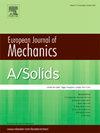Effects of high-cycle fatigue on the viscoelastic properties of epoxy resin
IF 4.4
2区 工程技术
Q1 MECHANICS
引用次数: 0
Abstract
In this work, the effects of high-cycle fatigue on the viscoelastic properties of a commercially available epoxy resin material were investigated experimentally. Specimens produced from neat epoxy material were split into two batches designated as pristine and fatigued. The specimens of the latter batch were subjected to a high-cycle fatigue loading under different stress amplitudes with a constant stress ratio of until failure. The storage and loss modulus, loss factor, and glass transition temperature () of the pristine and fatigued specimens were measured using dynamic mechanical analysis. Complementary temperature-modulated differential scanning calorimetry was employed to analyze the changes in of the pristine and fatigued specimens. A systematic comparison of the pristine and fatigued materials strongly indicates that changes in the viscoelastic material properties before and after fatigue loading were statistically insignificant. The findings strongly corroborate the hypothesis that, within the tested stress ratio, the viscoelastic properties of the tested epoxy resin remain independent of the mechanically applied load cycles in the high-cycle fatigue regime.

求助全文
约1分钟内获得全文
求助全文
来源期刊
CiteScore
7.00
自引率
7.30%
发文量
275
审稿时长
48 days
期刊介绍:
The European Journal of Mechanics endash; A/Solids continues to publish articles in English in all areas of Solid Mechanics from the physical and mathematical basis to materials engineering, technological applications and methods of modern computational mechanics, both pure and applied research.

 求助内容:
求助内容: 应助结果提醒方式:
应助结果提醒方式:


